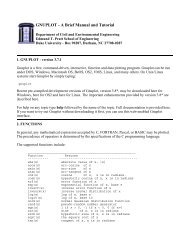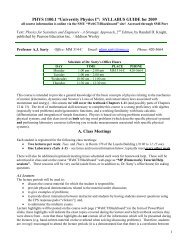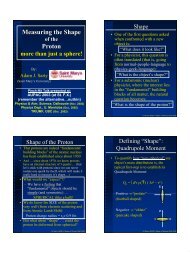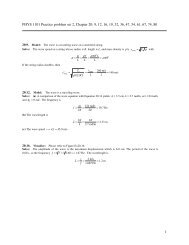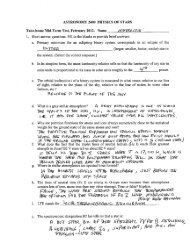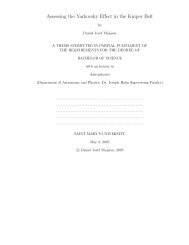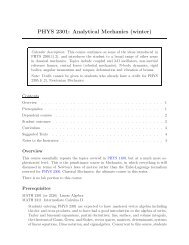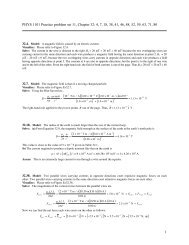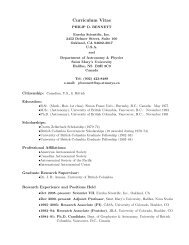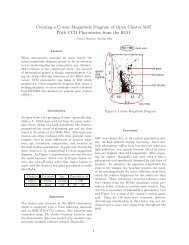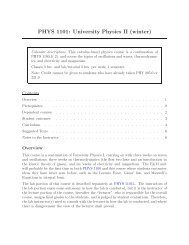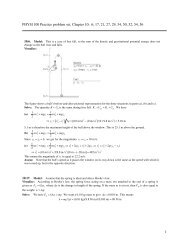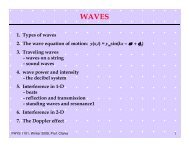1 PHYS1100 Practice problem set, Chapter 14: 4, 8, 13, 16, 18, 22 ...
1 PHYS1100 Practice problem set, Chapter 14: 4, 8, 13, 16, 18, 22 ...
1 PHYS1100 Practice problem set, Chapter 14: 4, 8, 13, 16, 18, 22 ...
You also want an ePaper? Increase the reach of your titles
YUMPU automatically turns print PDFs into web optimized ePapers that Google loves.
<strong>PHYS1100</strong> <strong>Practice</strong> <strong>problem</strong> <strong>set</strong>, <strong>Chapter</strong> <strong>14</strong>: 4, 8, <strong>13</strong>, <strong>16</strong>, <strong>18</strong>, <strong>22</strong>, 35, 36, 43, 61, 67, 75<br />
<strong>14</strong>.4. Model: The air-track glider attached to a spring is in simple harmonic motion.<br />
Visualize: The position of the glider can be represented as x(t) = A cos ωt.<br />
Solve: The glider is pulled to the right and released from rest at t = 0 s . It then oscillates with a period T = 2.0 s<br />
and a maximum speed v<br />
max<br />
= 40 cm s = 0.40 m s .<br />
(a)<br />
2 2 v 0.40 m s<br />
v = π π<br />
max<br />
ω A ω = A<br />
T<br />
= π<br />
2.0 s = ⇒ = ω<br />
= π rad s<br />
= =<br />
max<br />
and rad s 0.127 m 12.7 cm<br />
(b) The glider’s position at t = 0.25 s is<br />
( ) ⎡( π )( )<br />
x0.25 s<br />
= 0.127 m cos<br />
⎣<br />
rad s 0.25 s ⎤<br />
⎦<br />
= 0.090 m = 9.0 cm<br />
2<br />
<strong>14</strong>.8. Visualize: A phase constant of − π 3<br />
implies that the object that undergoes simple harmonic motion is in<br />
the third quadrant of the circular motion diagram. That is, the object is moving to the right.<br />
Solve: The position of the object is given by the equation<br />
2<br />
( ) = ( + ) = ( + ) = ( ) ⎡( ) −<br />
x t Acos ωt φ0 Acos 2π ft φ0 6.0 cm cos<br />
⎣ π rad s t<br />
3<br />
π rad⎤<br />
⎦<br />
1<br />
The amplitude is A = 6 cm and the period is T = 1 f = 2.0 s. With φ0 = − 2π<br />
3 rad, x starts at − A 2<br />
and is moving<br />
to the right (getting more positive).<br />
Assess:<br />
As we see from the graph, the object starts out moving to the right.<br />
<strong>14</strong>.<strong>13</strong>. Model: The air-track glider attached to a spring is in simple harmonic motion.<br />
T = 12.0 s 10 oscillations = 1.20 s. Using the formula for the period,<br />
Solve: Experimentally, the period is ( ) ( )<br />
2 2<br />
m ⎛ 2π<br />
⎞ ⎛ 2π<br />
⎞<br />
T = 2π<br />
⇒ k = m<br />
( 0.200 kg)<br />
5.48 N m<br />
k<br />
⎜<br />
T<br />
⎟ = ⎜ =<br />
1.20 s<br />
⎟<br />
⎝ ⎠ ⎝ ⎠<br />
1
<strong>14</strong>.<strong>16</strong>. Model: The mass attached to the spring is in simple harmonic motion.<br />
Solve: (a) The period is<br />
( 0.507 kg)<br />
( 20 N m)<br />
m<br />
T = 2π<br />
= 2π<br />
= 1.00 s<br />
k<br />
(b) The angular frequency is ω = 2π T = 2π 1.0 s = 2 π rad s.<br />
(c) To calculate the phase constant φ<br />
0<br />
,<br />
−<br />
( ) ( )<br />
x = Acosφ ⇒ 0.05 m = 0.10 m cosφ ⇒ φ = cos = ± π rad<br />
1 1 1<br />
0 0 0 0 2 3<br />
Because the mass is moving to the right at t = 0 s, it is in the lower half of the circular motion diagram. Hence,<br />
1<br />
φ0 = −<br />
3<br />
π rad.<br />
(d) At t = 0 s, v ( t) ( 0.10 m)( 2 π rad s) sin( 2π t φ )<br />
x<br />
= − + becomes<br />
1<br />
( )( π ) ( π )<br />
0<br />
− 0.10 m 2 rad s sin − rad = 0.544 m s<br />
(e) The maximum speed v ω A ( π )( )<br />
max<br />
= = 2 rad s 0.10 m = 0.628 m s .<br />
x1.3 s<br />
= 0.10 m cos⎡<br />
⎣<br />
2π 1.3 s −<br />
3π<br />
rad⎤<br />
⎦<br />
= 0.0669 m .<br />
(g) At t = 1.3 s, ( ) ( )<br />
1<br />
v π ⎣<br />
⎡ π π<br />
= − 0.10 m 2 rad s sin 2 rad s 1.3 s −<br />
1.3 s 3<br />
rad = −0.467 m s<br />
x<br />
(h) At t = 1.3 s, ( ) ( )( ) ( )( )<br />
1<br />
3<br />
⎦<br />
⎤<br />
.<br />
<strong>14</strong>.<strong>18</strong>. Model: The vertical oscillations constitute simple harmonic motion.<br />
Visualize:<br />
Solve: (a) At equilibrium, Newton’s first law applied to the physics book is<br />
( sp )<br />
F − mg = 0 N ⇒ −k∆y − mg = 0 N<br />
y<br />
2<br />
( )( ) ( )<br />
⇒ k = −mg ∆ y = − 0.500 kg 9.8 m s − 0.20 m = 24.5 N m<br />
(b) To calculate the period:<br />
k 24.5 N m 2π<br />
2 π rad<br />
ω = = = 7.0 rad s and T = = = 0.898 s<br />
m 0.50 kg ω 7.0 rad s<br />
(c) The maximum speed is<br />
( )( )<br />
vmax = Aω = 0.10 m 7.0 rad s = 0.70 m s<br />
Maximum speed occurs as the book passes through the equilibrium position.<br />
2
<strong>14</strong>.<strong>22</strong>. Model: Assume a small angle of oscillation so there is simple harmonic motion.<br />
Solve: The period of the pendulum is<br />
T<br />
L<br />
π<br />
g<br />
0<br />
0<br />
= 2 = 4.0 s<br />
(a) The period is independent of the mass and depends only on the length. Thus T = T0 = 4.0 s.<br />
(b) For a new length L = 2L 0 ,<br />
(c) For a new length L = L 0 /2,<br />
2L<br />
T = π = =<br />
g<br />
0<br />
2 2T0<br />
5.66 s<br />
L 2 1<br />
T = π = =<br />
g 2<br />
0<br />
2 T0<br />
2.83 s<br />
(d) The period is independent of the amplitude as long as there is simple harmonic motion. Thus T = 4.0 s.<br />
<strong>14</strong>.35. Model: The vertical mass/spring systems are in simple harmonic motion.<br />
Visualize: Please refer to Figure P<strong>14</strong>.35.<br />
Solve: (a) For system A, the maximum speed while traveling in the upward direction corresponds to the<br />
maximum positive slope, which is at t = 3.0 s. The frequency of oscillation is 0.25 Hz.<br />
(b) For system B, all the energy is potential energy when the position is at maximum amplitude, which for the first time<br />
is at t = 1.5 s. The time period of system B is thus 6.0 s.<br />
(c) Spring/mass A undergoes three oscillations in 12 s, giving it a period T<br />
A<br />
= 4.0 s. Spring/mass B undergoes 2<br />
oscillations in 12 s, giving it a period T<br />
B<br />
= 6.0 s. We have<br />
If m A = m B , then<br />
T<br />
A<br />
mA mB T ⎛<br />
A<br />
m ⎞⎛<br />
A<br />
k ⎞<br />
B<br />
4.0 s 2<br />
= 2 π and TB<br />
= 2π<br />
⇒ = ⎜ ⎟⎜ ⎟ = =<br />
kA kB TB ⎝ mB ⎠⎝ kA<br />
⎠ 6.0 s 3<br />
k<br />
k<br />
B<br />
A<br />
= ⇒ = =<br />
A<br />
4 k 9<br />
9 k 4<br />
B<br />
2.25<br />
3
<strong>14</strong>.36. Model: The astronaut attached to the spring is in simple harmonic motion.<br />
Visualize: Please refer to Figure P<strong>14</strong>.36.<br />
Solve: (a) From the graph, T = 3.0 s, so we have<br />
2 2<br />
m ⎛ T ⎞ ⎛ 3.0 s ⎞<br />
T = 2π<br />
⇒ m = k ( 240 N m)<br />
54.7 kg<br />
k<br />
⎜<br />
2π<br />
⎟ = ⎜ =<br />
2π<br />
⎟<br />
⎝ ⎠ ⎝ ⎠<br />
1<br />
(b) Oscillations occur about an equilibrium position of 1.0 m. From the graph, A ( )<br />
0 rad, and<br />
The equation for the position of the astronaut is<br />
2π<br />
2π<br />
ω = = = 2.094 rad s<br />
T 3.0 s<br />
x( t) A ωt ( ) ⎡<br />
⎣( ) t⎤<br />
⎦<br />
( ) ( ) ( )<br />
= cos + 1.0 m = 0.4 m cos 2.094 rad s + 1.0 m<br />
=<br />
2<br />
0.80 m = 0.40 m, φ0<br />
=<br />
⇒ 1.2 m= 0.4 m cos⎡ ⎣<br />
2.094 rad s t⎤ ⎦<br />
+ 1.0 m ⇒ cos⎡ ⎣<br />
2.094 rad s t⎤<br />
⎦<br />
= 0.5 ⇒ t = 0.50 s<br />
The equation for the velocity of the astronaut is<br />
Thus her speed is 0.725 m/s.<br />
vx<br />
( t) = −Aω<br />
sin( ωt)<br />
( )( ) ⎡( )( )<br />
⇒ v0.5 s<br />
= − 0.4 m 2.094 rad s sin<br />
⎣<br />
2.094 rad s 0.50 s ⎤<br />
⎦<br />
= −0.725 m s<br />
<strong>14</strong>.43. Model: The ball attached to a spring is in simple harmonic motion.<br />
Solve: (a) Let t = 0 s be the instant when x 0 = −5 cm and v 0 = 20 cm/s. The oscillation frequency is<br />
Using Equation <strong>14</strong>.27, the amplitude of the oscillation is<br />
(b) The maximum acceleration is a<br />
ω = k 2.5 N m 5.0 rad/s<br />
m<br />
= 0.10 kg<br />
=<br />
2<br />
2 ⎛ v0<br />
⎞<br />
2 ⎛ 20 cm /s ⎞<br />
A = x0<br />
+ ⎜ ⎟ = ( − 5 cm)<br />
+ ⎜ ⎟ = 6.40 cm<br />
⎝ ω ⎠ ⎝ 5 rad/s ⎠<br />
2 2<br />
max<br />
= ω A = <strong>16</strong>0 cm s .<br />
(c) For an oscillator, the acceleration is most positive ( a = a max ) when the displacement is most negative<br />
( x = − x = − A)<br />
. So the acceleration is maximum when x = − 6.40 cm .<br />
max<br />
(d) We can use the conservation of energy between x<br />
0<br />
= − 5 cm and x 1 = 3 cm:<br />
( )<br />
1 2 1 2 1 2 1 2 2 2 2<br />
2<br />
mv0 +<br />
2<br />
kx0 =<br />
2<br />
mv1 +<br />
2<br />
kx1 ⇒ v k<br />
1<br />
= v0 + x0 − x1<br />
= 0.283 m s = 28.3 cm s<br />
m<br />
Because k is known in SI units of N/m, the energy calculation must be done using SI units of m, m/s, and kg.<br />
2<br />
4
<strong>14</strong>.61. Model: A completely inelastic collision between the two gliders resulting in simple harmonic motion.<br />
Visualize:<br />
Let us denote the 250 g and 500 g masses as m 1 and m 2 , which have initial velocities v i1 and v i2 . After m 1 collides<br />
with and sticks to m 2 , the two masses move together with velocity v f .<br />
Solve: The momentum conservation equation pf = pi<br />
for the completely inelastic collision is ( m + m ) v =<br />
m v<br />
+ m v . Substituting the given values,<br />
1 i1 2 i2<br />
( ) v ( )( ) ( )( )<br />
0.750 kg = 0.25 kg 1.20 m s + 0.50 kg 0 m s ⇒ v = 0.40 m s<br />
We now use the conservation of mechanical energy equation:<br />
f<br />
1 1<br />
( ) ( ) ( )<br />
K + U = K + U ⇒ 0 J + kA = m + m v + 0 J<br />
2 2<br />
s compressed<br />
s equilibrium<br />
2 2 1 2 f<br />
m<br />
+ m<br />
k<br />
0.750 kg<br />
( 0.40 m s ) 0.110 m<br />
10 N m<br />
1 2<br />
⇒ A = vf<br />
= =<br />
The period is<br />
m1 + m2 0.750 kg<br />
T = 2π<br />
= 2π<br />
= 1.72 s<br />
k 10 N m<br />
f<br />
1 2 f<br />
5
<strong>14</strong>.67. Model: Assume that r marble<br />



